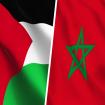
Tourism: 2020 VISION
Entitled "2020 Vision", the national tourism strategy aims to make tourism a cornerstone of the economic, social and cultural development and overtly seeks to place Morocco among the 20 top rated tourist destinations in the world, to position it as a top reference for sustainable development in the Mediterranean region, through a unique tourism model, combining sustained growth with responsible environmental management and respect for socio-cultural authenticity.
This ambition is driven by three main strategic objectives: doubling the tourist accommodation capacity by creating 200,000 new beds, doubling the number of tourists, by doubling Morocco's market share in the main traditional European markets, attracting 1 million tourists from emerging markets; and tripling the number of domestic trips.
This new development model builds, in large part, on three main foundations: a territorial planning policy for the tourism offer, ensuring an optimal distribution of the benefits of tourism and the achievement of socio-economic development in all regions of the Kingdom; a new governance structure capable of providing the necessary dynamics and leadership; and finally an integrated approach to sustainable development that respects the environment and socio-cultural authenticity.
The accompanying strategic plan provides for structural programmes to diversify the product portfolio, an integrated system for the development of sustainable tourism, a promotion plan and air services in line with the ambitions of the regions, support measures for a sustained and sustainable investment dynamic, a plan for the valorisation of human capital and top-notch training and a strategy to enhance the competitiveness of the sector and the professionalization of the stakeholders involved in the tourism value chain.
Agriculture: THE GREEN MOROCCO PLAN
Launched in 2008, the Green Morocco Plan (GMP) is an ambitious strategy that aims to transform the agricultural sector into a genuine lever for socio-economic development in Morocco, through accelerating economic growth, reducing poverty and promoting the integration of agriculture into national and international markets.
This strategy is built around seven foundations:
- Consider agriculture as Morocco's main growth driver for the next 10 to 15 years, through the strengthening of its contribution to the national GDP, creation of 1.5 million additional jobs, improvement of the agricultural income, increase in the value of exports
- Adopt aggregation as a model for the organisation of agriculture (new subsidy system, preferential access to land, financing and benefits of inter-professional organisations, creation of an investment guarantee fund).
- Ensure the development of Moroccan agriculture as a whole without exclusion through the implementation of two pillars: Pillar I focuses on modern agriculture with high added value and high productivity while Pillar II concerns solidarity support for small-scale agriculture
- Promote private investment accompanied by public aid (attract an annual investment of 10 million Dirhams via a targeted Morocco Offer)
- Adopt a contractual approach to implement the Green Morocco Plan (implementation of 1500 concrete projects)
- Sustain the development of Moroccan agriculture (integration into the "Climate Change" dimension at the project design stage, conversion of nearly one million hectares of cereals to fruit plantations which are likely to protect agricultural areas, support for the use of water-saving irrigation systems, support for the wider use of renewable energy).
- Prepare the reform of the sectoral framework (adoption of new land policy, adoption of new water policy, modernisation of the taxation system, modernisation of the national market, support, monitoring and evaluation).
Industry: INDUSTRIAL ACCELERATION PLAN
The National Pact for Industrial Emergence (2009-2015) is an integrated development strategy that seeks to achieve economic revitalization by mobilising and coordinating the actions of the State and economic operators to build a strong industrial sector.
The new industrial strategy, called « 2014-2020 Industrial Acceleration Plan » builds on the achievements made and stays focused on the World Crafts of Morocco while integrating other traditional sectors of the national industrial fabric, such as textiles and leather.
This plan sets ten key measures, grouped into three blocks:
- The first block of measures aims at reducing sectoral fragmentation and building a better-integrated industry, whose logic of ecosystems is the anchor point and the main lever. That choice largely depends on setting up industrial ecosystems with a mission of creating new dynamics and a new type of relationship between large groups and SMEs, in order to reach cross-fertilization.
- The second block of measures concerns the implementation of support tools to improve the competitiveness of SMEs by giving them access to investors, financing and markets. The financial mechanism is covered by a specific programme, which includes the creation of the Industrial Development Fund, with a budget of 20 billion dirhams.
- The third block of measures aims to strengthen Morocco's attractiveness to Foreign Direct Investments, through the creation of a team, consisting of professionals of intermediation and experts by business line, responsible for 20 strategic prospects. The Industrial Acceleration Plan offers measures to promote the Morocco's African dimension, and favours South-South partnerships with a view to creating shared value.
Taken as a whole, these measures aim at creating 500 000 jobs, and increasing the share of industrial production in the GDP by 9 points, passing from 14% to 23% in 2020.
LOGISTICS: LOGISTICAL COMPETITIVENESS STRATEGY
The development of the logistics sector has always been regarded as a strategic priority in the process of strengthening the competitiveness of the Moroccan economy. The new logistics competitiveness strategy aims at positioning Morocco on the main logistics flows and helps meet the logistics needs of the various sectoral strategies launched or being implemented at the national level.
Listed below are the overall impacts of this strategy:
- Reducing Morocco's logistics costs for the benefit of consumers and strengthening the competitiveness of economic operators through an optimised, secure and massive management of the flow of goods (logistics costs at import/export and in domestic distribution channels).
- Accelerating GDP growth through increasing the added value induced by the decrease in logistics costs, particularly through the emergence of a competitive logistics sector with integrated logistics players and efficient service platforms seen as genuine centres of concentration and creation of logistical added value.
- Strengthening the logistics sector's contribution to the sustainable development of the country through the reduction of noise pollution (decrease in the number of tons/kilometres by 30% by 2015, reduction of CO2 emissions by 35% by 2015, reducing congestion on roads and cities).
In order to achieve the objectives set out above, the implementation of Morocco's new logistics strategy must be built around the following five key areas
- Developing and implementing an integrated national network of Multi-Flow Logistics Zones,
- Optimising and massifying the flow of goods,
- Upgrading and promoting the emergence of integrated and efficient logistics players,
- Developing skills through a national training plan in logistics professions,
- Establishing a governance framework for the sector and implementing appropriate regulatory measures.
Trade: RAWAJ PLAN
The trade and distribution development plan, entitled « RAWAJ », aims at organising and boosting the trade sector, with the aim of transforming it into a genuine lever for investment and socio-economic development.
This plan is built on three main components:
Ensuring the balance of the commercial network, enhancing the attractiveness of the commercial device and diversifying the range of products. In addition to organising spaces through a commercial urban planning policy based on a process of planning commercial facilities according to socio-economic criteria, and coherence between commercial hubs and forms of distribution and puts in place measures to fight against speculation in land and commercial premises. This component also aims to encourage new forms of distribution by creating accessible commercial activity areas and supporting the growth of distance commerce and the development of national brands, which can target all consumer segments (franchises, hard discount, etc.).
The second component supports the modernisation of convenience store (creation of the RAWAJ Fund with a budget of 900 million Dirhams), the promotion of urban commercial centres (Medinas, new neighbourhoods) and the organisation of non-sedentary trade (developed and dedicated commercial spaces, rural souks,).
And finally, the third component proposes an offer adapted to the needs of all consumers, in terms of supply of fresh products (national orientation scheme for fruit and vegetable wholesale markets) and accessibility to manufactured goods (Restructuration of the distribution channels for these products through reorganising the various stakeholders and reducing the number of intermediaries).
The implementation of the RAWAJ plan is accompanied by several transverse axes, such as :
- Providing sustainable social protection for traders,
- Defining a training programme adapted to the needs of the sector,
- Ensuring effective consumer protection
- Ensuring a strong professional representation
In addition to a monitoring and statistical system that promotes transparency in the sector.
Renewable Energies: 2030 ENERGY STRATEGY
The energy strategy reflects a forward-looking vision that aims to ensure the country's energy security through the diversification of national energy sources by means of promoting the use of alternative energies, broadening access to energy at competitive prices, developing advanced technologies that value various forms of professional expertise, preserving the environment and the health and safety of citizens.
To achieve these objectives, the energy strategy has laid down the following strategic guidelines
- An optimised electricity mix based on reliable and competitive technological choices (a plan for the installation of additional electrical powers will be implemented using clean and high-efficiency coal).
- The increase in the share of renewable energies (development of wind power, construction of solar power plants, Increased use of biomass, mobilisation of hydroelectric potential)
- Energy efficiency (creation of a dedicated agency, reform of the building code, development of green cities, promotion of cogeneration in industrial processes, modernisation of the transport fleet)
- Mobilisation of national resources (optimising the use of water deposits, proactive monitoring of nuclear technologies and launching of a feasibility study for the construction of nuclear power plants, intensification of oil exploration, direct combustion of oil shales for power generation and hydrocarbon production, ongoing investigation of new technologies more suited to the exploitation of the potential of biomass, search for sites conducive to the development of geothermal energy).
- Regional integration (extension of electricity interconnections with Spain and Algeria, access to the Mediterranean electricity loop, integration into the Mediterranean Solar Plan)
- Balance between national production and energy imports (construction of port storage capacities in the various ports of the country, fiscal neutrality for energy products by exempting them from import duties, domestic consumption tax and others taxes, promotion of tax incentives for alternative energies by exempting them from import duties and taxes on equipment and components necessary for the production of renewable energies and the promotion of energy efficiency.)
Sea Fishing: HALIEUTIS
Morocco ranks among the most competitive countries in the world in terms of fisheries exports. In addition, the Exclusive Economic Zone (EEZ), which is characterised by a very broad range of resources (500 species, 60 of which are exploited) helped to position Morocco as a global leader on the international market for canned sardines, with an export market share of more than 40%.
The new Strategy for the Development and Competitiveness of the Fisheries sector, known as "Halieutis" aims, in general, at building a sustainable and competitive fishing industry, that promotes the country's fishing heritage and transforms the sector into a genuine engine for economic growth.
This strategy is also seeking to promote genuine upstream-downstream integration and strengthen cooperation between all the players to ensure an effective co-management of the fishing sector. It focuses on three main areas:
- Sustainability: Ensure the sustainability of resources and make fishermen the primary actors of a responsible fishing.
- Performance: Organise and equip the sector for optimal quality, from landing (transparency throughout the value chain) to marketing (mechanisms for selling on efficient markets).
- Competitiveness: Enhance the value of products on promising markets by ensuring the availability and regularity of a quality raw material.
The implementation of this strategy relies on five key tools related to cross-cutting functions of governance, financing, promotion, development, technology watch and training:
- National Committee for Fisheries
- Funds for the adjustment and modernization of fishing effort
- National Agency for the Development of Moroccan Aquaculture (ANDA)
- Seafood processing Centre
- Fisheries Sector Employment Observatory
Ports: 2030 NATIONAL PORT STRATEGY
Seen as a key component of the logistics chains, the ports of Morocco are a powerful lever for development, whose performance is of vital importance.
The kingdom's 2030 National Port Strategy aims to accompany the evolution of the national economy through anticipating the demand for port infrastructure and strengthening the country's global competitiveness.
The port development strategy covers several issues, including:
- Optimising the competitiveness of the logistics chain and developing resources
- Ensuring the security of strategic supplies
- Strengthening the port system's capacity to adapt to regional and international changes in order to grasp geostrategic opportunities.
The overall objective of this vision is to consolidate the market share of international maritime trade and cruises through the integration of the port system into the regional transport network. It defines an integrated offer in line with the port demand, composed of six geographically integrated hubs, taking advantage of the major structuring projects and enhancing the comparative advantages of each region:
- The Oriental hub oriented towards Europe and Mediterranean countries , especially the Maghreb;
- The North-West hub, gateway to the Strait of Gibraltar and Tangier
- The hub of Kenitra-Casablanca which includes two ports, Mohammedia and Casablanca, within the same conurbation;
- The Abda - Doukkala hub, centre of heavy industry, with Jorf and Safi;
- The Souss - Tensift hub, with the port complex of Agadir;
- The Hub of ports in the south of Morocco, grouping together 3 ports: Tan Tan, Laâyoune, and Dakhla.0
Craft: MOROCCO'S 2015 VISION FOR CRAFT INDUSTRY
The 2015 craft industry vision aims at restructuring the craft sector through the implementation of a policy that is tailored to each type of stakeholder in the sector and satisfies a twofold objective: help emerge and develop a reference network of actors-producers and support urban and rural mono-craftsmen in order to increase their income by means of increasing their production/sales
In order to ensure the continuity of this vision, the allocation of roles and responsibilities among the stakeholders, identification of the main lines of financing and mobilisation of all stakeholders. A Tripartite Contract - Programme was signed by the Government, the Federation of Chambers of Crafts and the Representative of Professional Associations.
The objectives pursued include increasing the turnover of crafts with cultural content, increasing formal exports, creating 117,500 additional jobs and increasing the GDP by 4 billion dirhams.
In order to implement this strategy, the State provides for cross-cutting support measures for the benefit of the various actors in the sector. These measures focus on three main areas:
- Promotion: Institutional advertising, promotion of the tourism sector, policy of promoting a flagship label.
- Labelling: creation of a national flagship label in the short term and ensuring its application by key sectors or professions;
- Training: Upgrade of the existing system, focus on apprenticeship training, and implementation of a certification system for craftsmen.
The craft strategy also provides for action levers relating to governance, through optimising the sharing of roles between the various institutional stakeholders (Ministry, Chambers of Crafts and their federations, Maison de l'Artisan (craftsman's house), Office for the Development of Cooperation), as well as neighbourhood actions (involvement of professional associations) and monitoring actions (establishment of the Observatory of Crafts).



